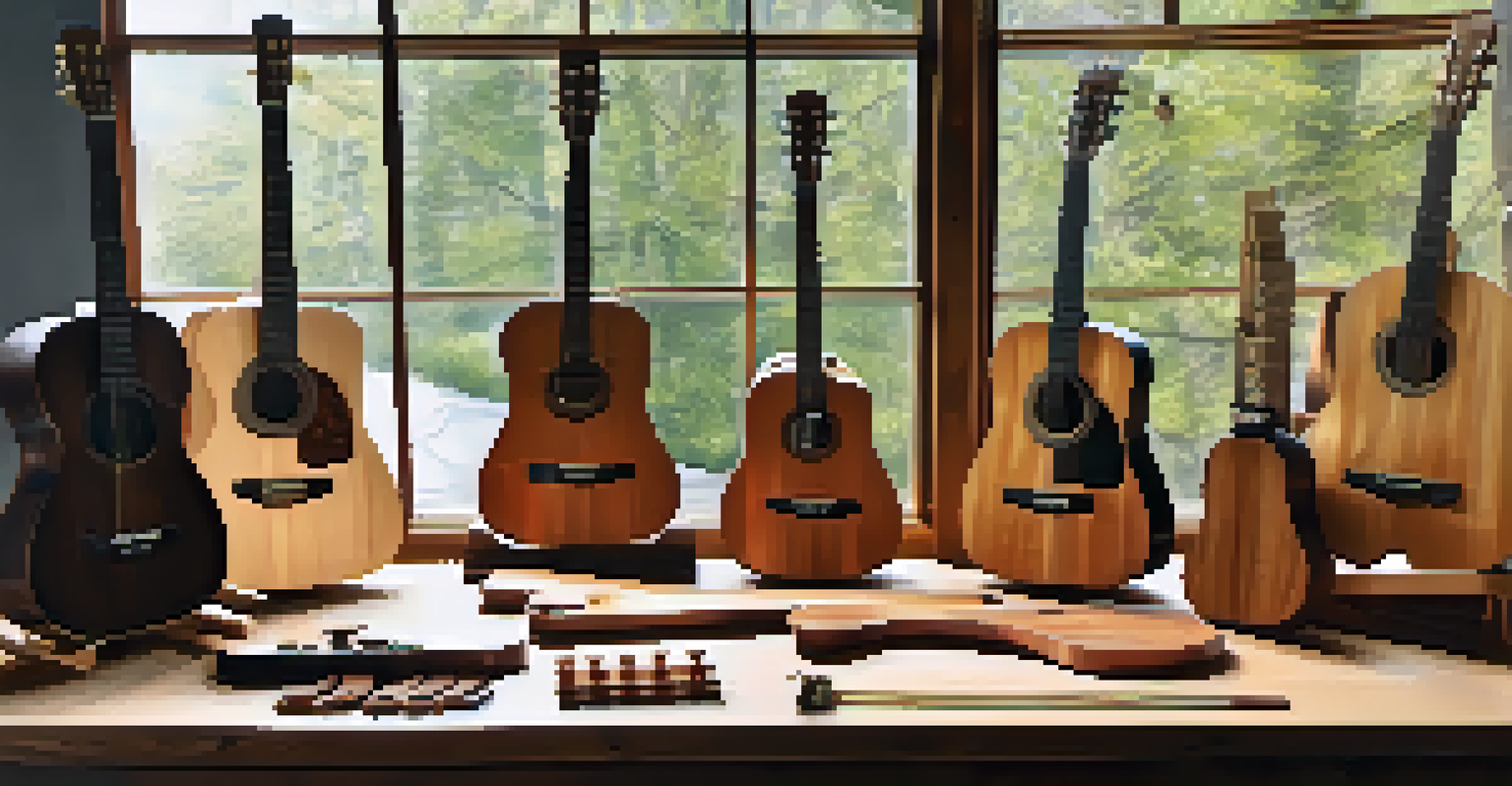The Role of Tonewoods in Guitar Construction Explained

What Are Tonewoods and Why Do They Matter?
Tonewoods refer to the types of wood used in guitar construction, playing a critical role in shaping the instrument's sound. Different woods possess unique acoustic properties that can greatly influence the tone, resonance, and overall character of the guitar. For instance, a guitar crafted from mahogany often produces a warm, mellow sound, while one made from spruce tends to deliver bright, crisp tones.
The wood you choose for your guitar can make all the difference in the sound you produce.
The choice of tonewood can affect not just the sound, but also the feel of the instrument. Guitars made with lighter woods may be easier to handle, while denser woods can provide more sustain. Musicians often choose their instruments based on how the wood feels and sounds, making tonewood selection a crucial decision in guitar construction.
In essence, tonewoods serve as the foundation of a guitar's voice. Understanding the different types of tonewoods can help players select the right instrument to match their musical style and preferences.
Common Tonewoods and Their Characteristics
There are several popular tonewoods used in guitar making, each bringing its own flavor to the music. For example, cedar is favored for classical guitars due to its rich, warm sound, while maple is known for its bright, clear tones and stunning visual appeal. These woods are often chosen based on the desired sound profile and aesthetic of the guitar.

Rosewood is another widely used tonewood, appreciated for its complex overtones and deep bass response. Many acoustic guitars feature rosewood fingerboards, enhancing both playability and sound quality. Each type of wood contributes to a unique sonic palette, allowing guitarists to find the perfect match for their musical expression.
Tonewoods Shape Guitar Sound
The type of wood used in guitar construction significantly influences the instrument's tone, resonance, and overall character.
By familiarizing themselves with these common tonewoods, musicians can make more informed choices when purchasing a guitar. This knowledge not only enriches their playing experience but also deepens their appreciation for the craftsmanship behind the instrument.
How Tonewoods Affect Sound Quality
The sound quality of a guitar is heavily influenced by the tonewoods used in its construction. The density, grain structure, and moisture content of the wood all contribute to how sound waves travel through the instrument. For example, denser woods like mahogany can create a more focused sound, while lighter woods offer a more open tone.
Tonewoods are the soul of the guitar, shaping its voice and character.
Moreover, the way different tonewoods vibrate affects the sustain and projection of the notes played. A guitar with a solid top, often made from premium tonewood, will generally have a richer and more dynamic sound compared to one with a laminate top. This distinction highlights the importance of selecting high-quality tonewoods for optimal sound performance.
Ultimately, the interplay between tonewoods and sound quality is what gives each guitar its unique voice. Musicians often experiment with different woods to find the tonal qualities that best suit their playing style.
The Impact of Wood Grain on Sound
The grain of the wood is another essential factor in guitar tone. Straight-grained woods are typically preferred for their predictable acoustic properties, while irregular grains can introduce unique tonal characteristics. This is why some luthiers seek out rare or unusual wood grains to create custom guitars with distinctive sounds.
The orientation of the wood grain can also affect how the instrument resonates. For example, quartersawn wood, where the grain is cut at a right angle to the growth rings, tends to produce a more stable and consistent tone. Understanding these nuances can help players appreciate the craftsmanship involved in their instruments.
Sustainability in Wood Sourcing
The increasing awareness of environmental impacts has led musicians and manufacturers to prioritize responsibly sourced tonewoods.
In essence, the wood grain not only enhances the aesthetic appeal of the guitar but also plays a vital role in shaping its sound. Musicians should consider both the visual and acoustic aspects of wood grain when selecting their ideal instrument.
The Role of Tonewoods in Electric Guitars
While tonewoods are often associated with acoustic guitars, they also play a significant role in electric guitar construction. The body wood can influence the sustain and resonance of the instrument, impacting the overall sound. For example, a solid body made from alder or ash can give an electric guitar a bright and punchy tone.
In contrast, mahogany is frequently used for electric guitar bodies to provide a warmer, thicker sound with enhanced mid-range frequencies. The choice of tonewood can therefore be a vital factor in shaping the character of an electric guitar, just as it is in acoustics.
Additionally, the combination of various woods in electric guitars can create complex tonal layers. Guitarists often experiment with different wood combinations to achieve their desired sound, showcasing the versatility of tonewoods in all types of guitars.
Sustainability in Tonewood Sourcing
The environmental impact of sourcing tonewoods has gained increasing attention in recent years. Many traditional tonewoods, such as rosewood and mahogany, are threatened due to overharvesting and habitat loss. As a result, musicians and manufacturers are becoming more conscious of sustainability and are seeking responsibly sourced materials.
Organizations and certifications, such as the Forest Stewardship Council (FSC), help ensure that wood is harvested in an environmentally friendly manner. By choosing guitars made from sustainable tonewoods, players can contribute to the preservation of forests and ecosystems while still enjoying high-quality instruments.
Innovation in Guitar Materials
Advancements in technology are paving the way for engineered woods and composite materials that mimic traditional tonewoods while promoting sustainability.
This shift towards sustainability not only benefits the planet but also encourages innovation in the guitar industry. Luthiers are exploring alternative materials and techniques that can produce similar acoustic qualities while being kinder to the environment.
The Future of Tonewoods in Guitar Construction
As the music industry evolves, so do the materials used in guitar construction. Innovations in technology and materials science are opening the door to new possibilities for tonewoods. For instance, engineered woods and composite materials are being developed to mimic the sound qualities of traditional tonewoods, offering consistency and sustainability.
Additionally, advancements in acoustic modeling and simulation allow luthiers to experiment with wood properties digitally before physically crafting the instrument. This technology helps in identifying the optimal wood combinations and structures for specific sound profiles.

The future of tonewoods in guitar construction is likely to be a blend of tradition and innovation, where classic woods coexist with new materials. This evolution will continue to shape the sound and playability of guitars, ensuring that musicians have access to a diverse range of options for their creative expression.